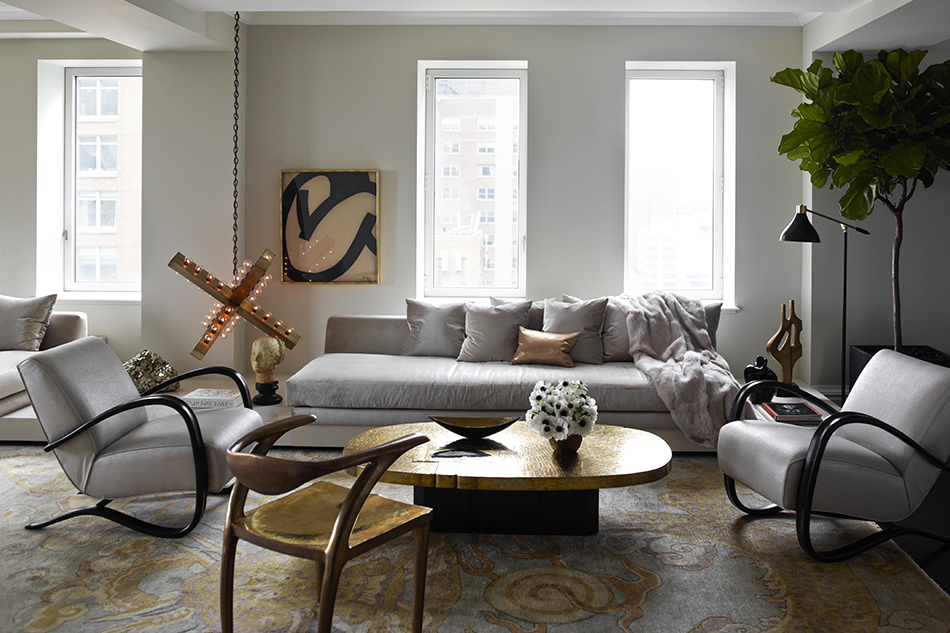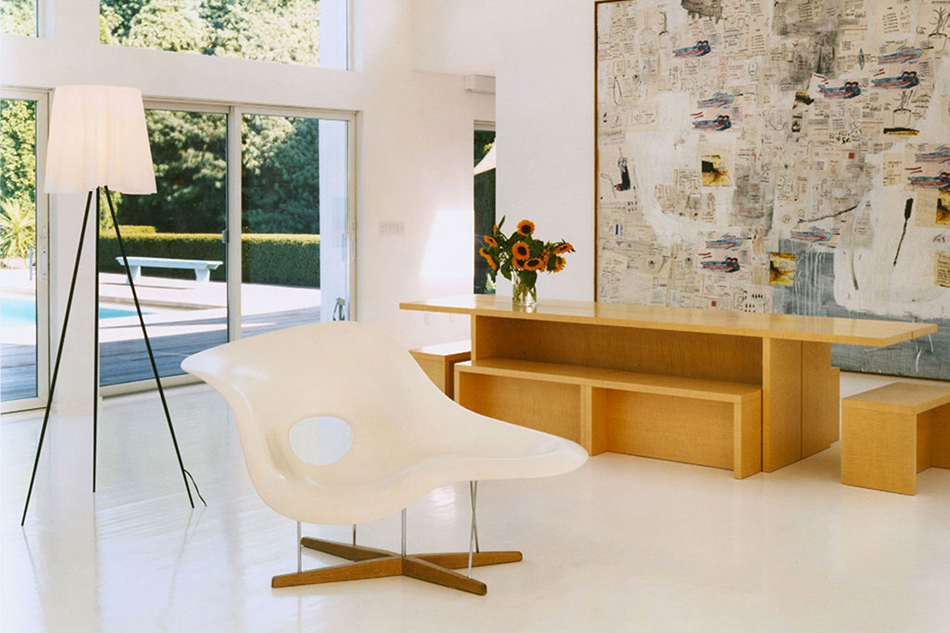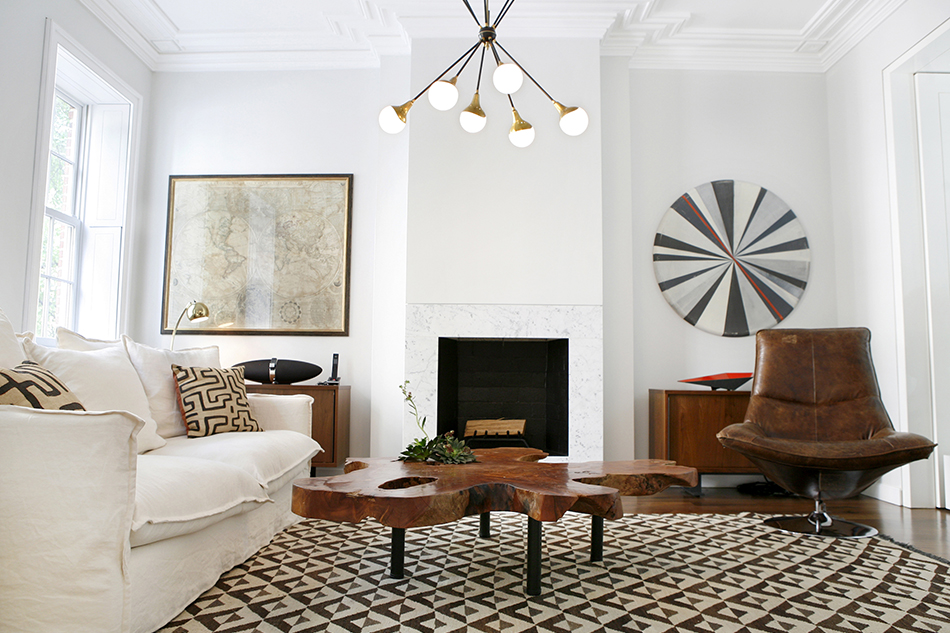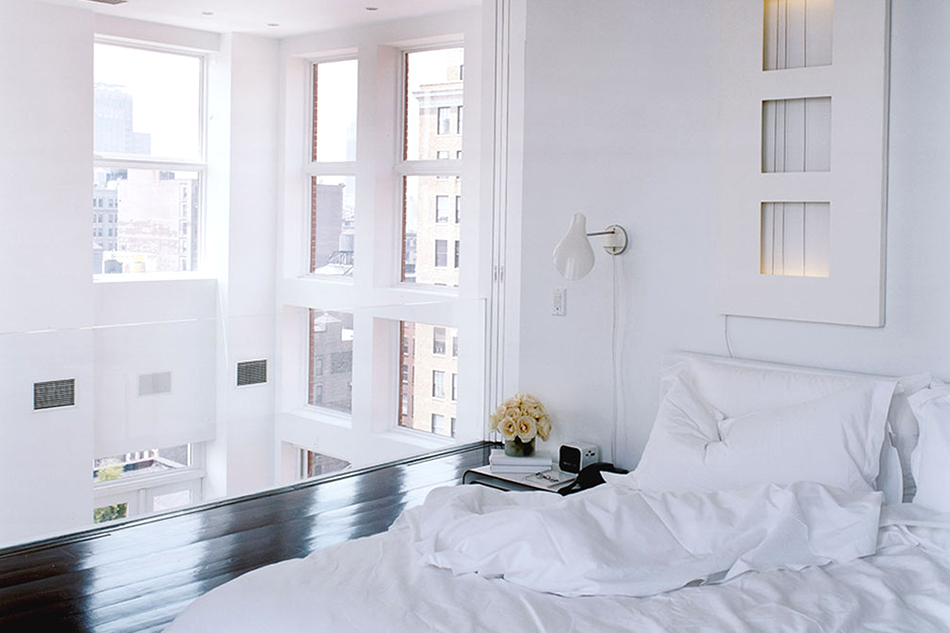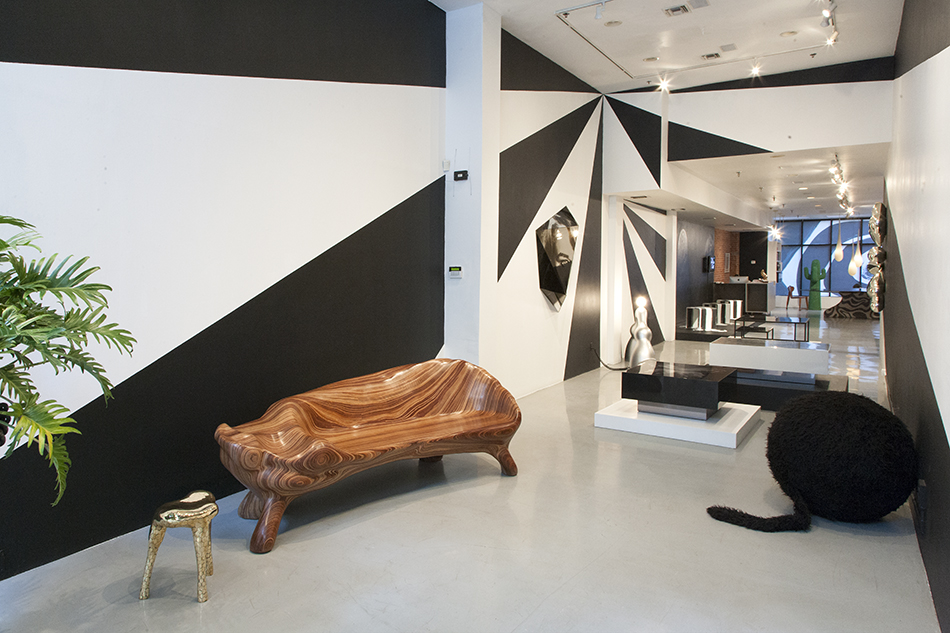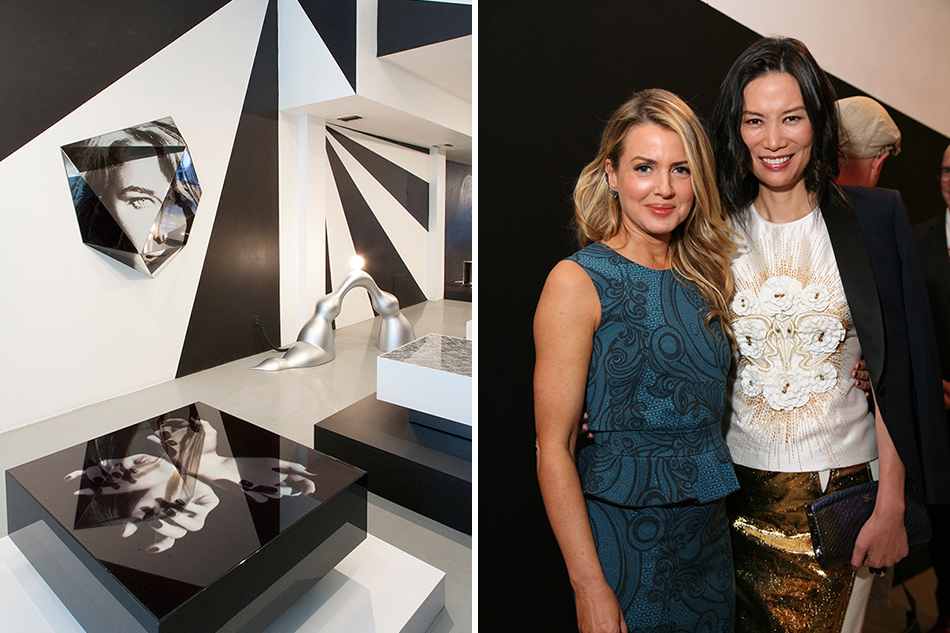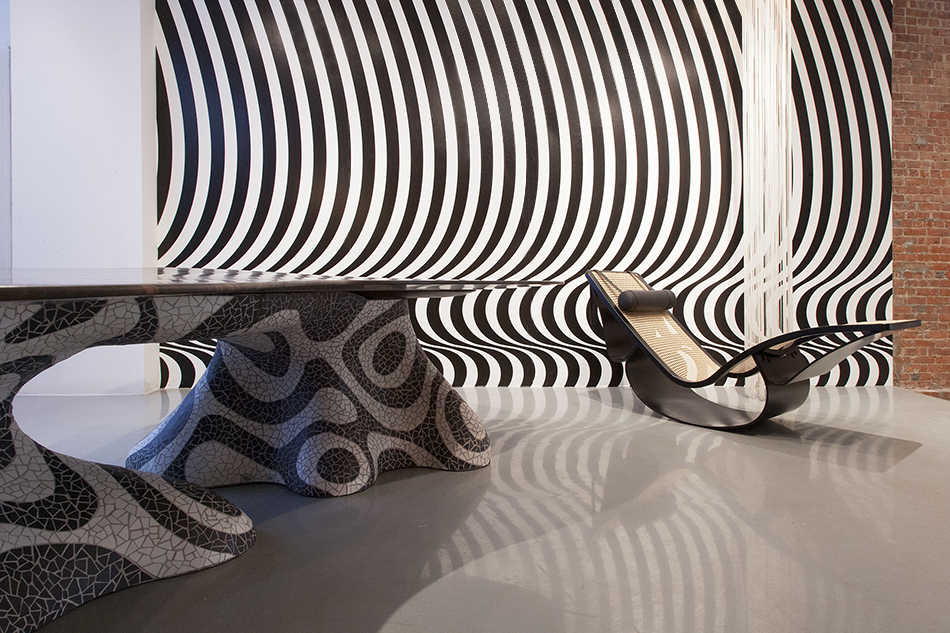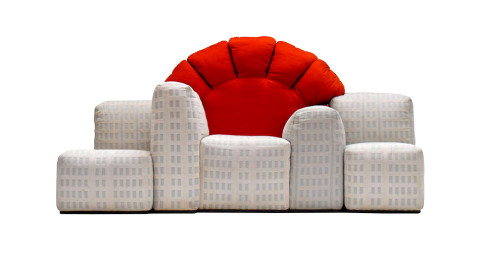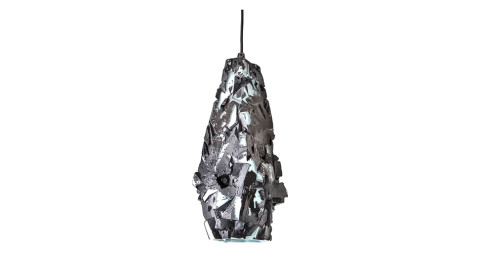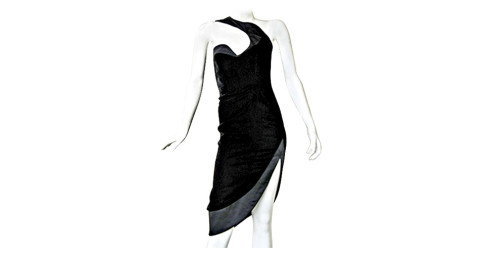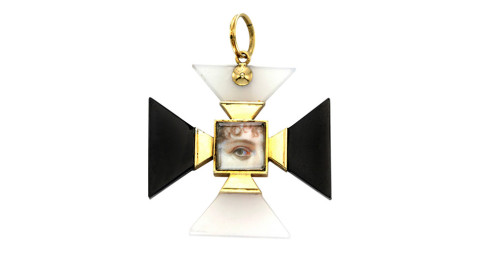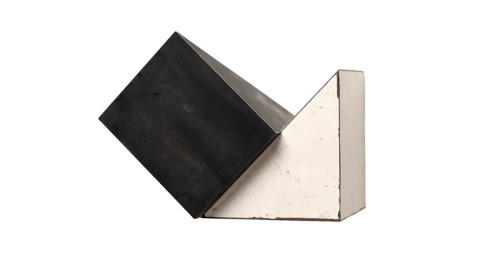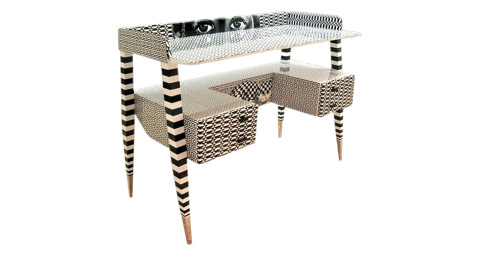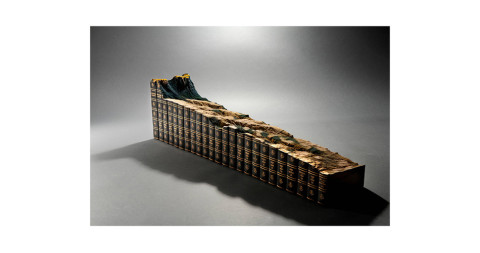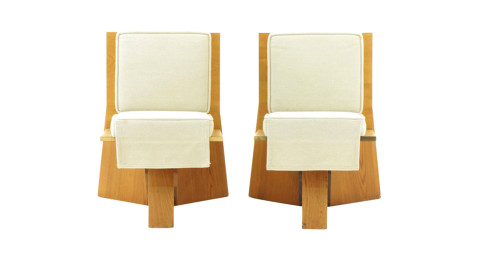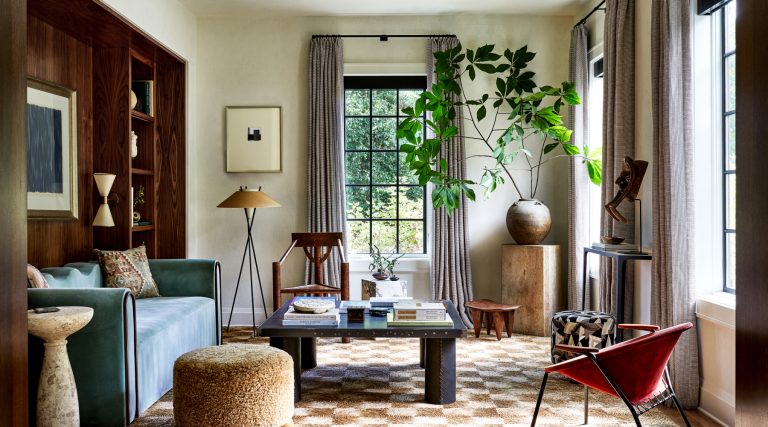
July 27, 2015Kelly Behun explored careers in finance, fashion retail and the music industry before discovering a passion — and talent — for interior design (photo by Daniel Kukla). Top: In the warmly white dining room of her home on New York’s Central Park West, Behun set a Kara Hamilton mural above a table and dining sofas designed by her own studio (photo by Gentl & Hyers).
Looking out from designer Kelly Behun’s cloud-white glass-enveloped penthouse aerie in Columbus Circle’s Trump International Tower, you’d be forgiven for ogling the impossibly spectacular views of Manhattan and New Jersey’s Palisades beyond. But it’s the interiors that really grab your attention. On a recent morning, Behun perches on a chair here, atop a snowy custom goatskin rug. Behind her, suspended over an equally immaculately white Vladimir Kagan sectional sofa, Tord Boontje’s crystal-encrusted branch chandelier emanates prismatic twinkles that resemble fairy dust. Behun is an adorable addition to this vignette: blonde-haired and blue-eyed, with pouty lips and extravagantly long baby-doll eyelashes. In this impressive setting, it would be easy to dismiss her as a princess in the tower of a crystal palace.
Yet there’s a downtown girl lurking in the deceptively pert, privileged profile. From one ear dangles a Salvador Dalí-esque earring in the form of a disembodied eye, nose and lips. Her blouse front displays the surreally foreshortened perspective of a topiary garden Alice might have discovered in the recesses of the rabbit hole. The wall in the adjacent dining room, painted by multimedia artist Kara Hamilton, has the slightly unsettling appearance of fissures in an overcast sky. And hanging above the table is a ghostly chandelier wrapped in gauzy fabric, calling to mind the cobwebbed specimen over Miss Havisham’s abandoned nuptial banquet table.
Many of Behun’s trademark touches can be seen here, even if her style, as she’s quick to note, is always evolving. “I tend to be a modernist,” says the designer, whose clients have included Ian Schrager, Ivanka Trump and Wendi Murdoch. “I try to achieve a blend of high and low. I use warm materials — human, humane — and I like things to have space around them; I’m not a maximalist.” As for art, she says, “I want to be pushed and to grow.” Hanging diverse her are diverse works by Peter Gee, Darren Waterston and Rob Wynne. And when asked about that whiter-than-white palette in her apartment, she observes, “A room is a landscape you create. White — a calming, cleansing absence of color — allows you to regroup and exhale, which is particularly important in New York. For me, it’s about how a room makes you feel emotionally.”

In the living room of her New York apartment, a Tord Boontje Blossom chandelier — and impressive views — sparkle over sofas Behun designed in collaboration with Vladimir Kagan. Photo by Gentl & Hyers
And, indeed, if there’s any one trait that Behun’s spaces share more than any other, it is this play to the emotions No matter the style, her designs never fail to stimulate. They do so with mod forms (the fabric-covered mushroom-like columns of the children’s playroom in her family’s weekend house in Southampton, for example), and through tactile fabrics and furnishings (woods, ethnic textiles and handwoven carpets in a Soho townhouse). Other times it is the odd juxtaposition, such as a table in the foyer of Ivanka Trump’s Park Avenue penthouse with a white-painted tree-trunk base and glitzy mosaic mirror top. And, frequently, it is through the deployment of art and objects possessing what she has called a “kook factor” (a 1970s Richard Etts lamp in a Carroll Gardens bedroom that looks like Thing from the Addams Family). Indeed, the storefront she maintains on 1stDibs, Kelly Behun Studio, is populated by items ranging from a graphic, hand-beaded African Yoruba chair and a handful of colorful Moroccan rag rugs to textured ceramic vessels she commissioned from the L.A. sculptor Brian Rochefort.
“I always knew I wanted to end up in New York,” avers the Pittsburgh native. Her father, a first-generation American whose own father had emigrated from Czechoslovakia, met her second-generation Irish mother while he was studying medicine at Georgetown. They moved to the steel town “when the city was still having a heyday.” Though she had no clear inclination toward design, Behun admits, “I had a strong sense when I went to people’s homes of what I was drawn to, how lighting affected me.”
“A room is a landscape you create…For me, it’s about how a room makes you feel emotionally.”

The double-height, light-filled living room of the Soho penthouse sees a pair of custom-slipcovered sofas by Kelly Behun Studio flanking a Tucker Robbins root table. Photo by Oberto Gili
At 17, she met Jay Sugarman, a brilliant high school classmate of hers, who went on to found the real estate investment firm iStar Financial, striking it rich at a young age. “I sat behind him in math,” says Behun, who married Sugarman 23 years ago. “Smart positioning on my part,” she adds, but not in reference to the comfortable life Sugarman’s success provided. Rather, she winks, “I could peek over his shoulder.” The couple has two extremely well-mannered boys — Arno, 15, and Miles, 12 — who the 53-year-old Behun describes, quite accurately, as “just delicious.”
It took Behun a while to find her calling. After earning her bachelor of science degree in economics at the University of Pennsylvania’s Wharton School, she worked at Salomon Brothers on the mortgage-backed securities floor. (“I lasted all of four weeks.”) For the next five years she shifted between retail apparel, the record industry and designing and selling her own greeting card line.
In 1994, she made the acquaintance of überhotelier Schrager and offered to apprentice with him for free. “He was an incredible mentor,” recalls Behun. Her natural talent soon surfaced, and Schrager insisted on putting Behun on his payroll. Her six years with him proved incredibly formative. Refreshingly, unlike many designers reticent to acknowledge their sources of inspiration for fear of being labeled derivative, Behun freely and gratefully acknowledges what she’s learned from others.
One such figure was celebrated French designer Andrée Putman, who helped Schrager launch the Morgans boutique hotel. Putman possessed, says Behun, “an unerring eye toward classic, tasteful proportion. She had unfailingly good taste and was extraordinarily elegant.” Behun also worked with Philippe Starck, whose work with Schrager on many hotels launched the French designer onto the American stage. From Starck, she inherited “an incredible sense of the possibilities of design, rewriting things and taking risks,” as well as a taste for the surreal.
From Anda Andrei, Starck’s design director, Behun absorbed practical skills. “Anda is amazing — smart, really talented, beautiful, chic,” says Behun admiringly. “She had the brains, skill and charm to corral the imagination of Philippe and combine it with the deadlines and budgets of Ian.”
It was Schrager who encouraged Behun to open her own design firm, which she did with another Schrager colleague, Natasha Ziff, in 2001. Their first client? Schrager himself, for whom the duo designed a loft in Soho. Behun went solo in 2010. Today, Kelly Behun Studio remains intentionally small, taking on just five or six projects a year, and “never more than three at a time,” she notes. “There has to be some hook: something I’ve never done before, a different location, people I really admire, a space that’s architecturally challenging. I want to make sure it’s something I’m not well suited to do because I don’t want to keep repeating what I do.”

Behun’s ebony and mosaic table makes another appearance at the designer’s own Southampton home, topped by a Pedro Friedeberg clock from Sebastian + Barquet, and coupled with a whimsical chair by Christian Astuguevieille. Photo by William Waldron
Part and parcel of every project is custom art furniture, on which she frequently collaborates with artists and artisans in various media. A series of these pieces were produced in limited editions for the 2012 exhibition “After” at R & Company in Tribeca, which Behun curated along with artist and designer Alex P. White (an associate at her firm). The show included new pieces by Behun as well as design collaborations with such creators as collage artists Lola Dupré and Gordon Magnin, fiber artist Sally England and mosaic artist Rhonda Heisler, among others, with some of the furniture and decorative objects taking inspiration, variously, from artists Lynda Benglis and Bridget Riley and landscape designer Roberto Burle Marx. (The show also featured pieces by R & Company’s own stable of designers, not least of all the Haas Brothers and Wendell Castle.)
These pieces, as well as others informed by movements as diverse as the 1930s avant-garde, 1960s Pop art and the Memphis Group, are available on Behun’s 1stDibs storefront, and Barney’s and Suite NY sell Behun’s Op Art lazy Susans. Behun is also at work on an upcoming collaboration with Volume Gallery in Chicago, a few Hamptons projects and a summer house in Kuwait.
“I like making all the decisions,” says Behun confidently about working for herself and on her own. But, at heart, it’s a much simpler proposition. “Growing up, our house was the one everyone wanted to come to,” she says of the home where she slept on a lacquered platform bed surrounded by a curved track from which hung drapes in Yves Klein blue. “That’s the kind of house I wanted to have.”
And, it might be added, the kind of house she likes to design.

